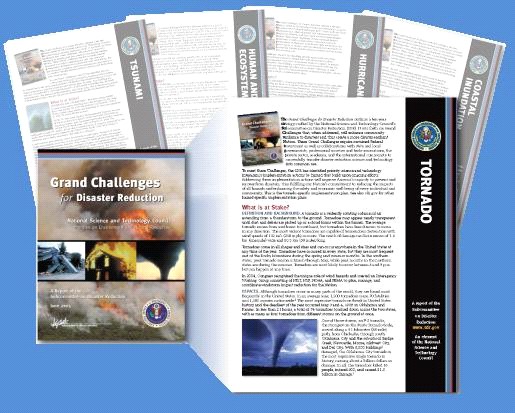Featured Reports and Plans
 Grand Challenges for Disaster Reduction
Grand Challenges for Disaster Reduction
Implementation Plans
Coastal Inundation
Drought
Earthquake
Flood
Heat Wave
Human and Ecosystem Health
Hurricane
Landslide and Debris Flow
Space Weather
Technological Disasters
Tornado
Tsunami
Volcano
Wildland Fire
Winter Storm
Site Survey
Sitemap
|
Related Interagency Groups
National Earthquake Hazards Reduction Program
The National Earthquake Hazards Reduction Program (NEHRP) is the Federal government's coordinated long-term nationwide program to reduce risks to life and property in the United States that result from earthquakes. Established by Congress in 1977, NEHRP seeks to reduce earthquake-related losses through improved design and construction methods and practices, land use controls and redevelopment, prediction techniques and early-warning systems, coordinated emergency preparedness plans, and public education and involvement programs.
National Space Weather Program
The National Space Weather Program (NSWP) is an interagency initiative to speed improvement of space weather services. It emerged in 1994 from the efforts of several U.S. government agencies to prepare the country to deal with technological vulnerabilities associated with the space environment. The overarching goal of the NSWP is to achieve an active, synergistic, interagency system to provide timely, accurate, and reliable space weather warnings, observations, specifications, and forecasts.
National Tsunami Hazard Mitigation Program
The National Tsunami Hazard Mitigation Program (NTHMP) is designed to reduce the impact of tsunamis through hazard assessment, warning guidance, and mitigation. The program is a partnership between the National Oceanic and Atmospheric Administration (NOAA), the United States Geological Survey (USGS), the Federal Emergency Management Agency (FEMA), the National Science Foundation (NSF), and the 28 U.S. Coastal States, Territories, and Commonwealths.
National Windstorm Impact Reduction Program
In 2004, Congress created the National Windstorm Impact Reduction Program (NWIRP) to reduce the loss of life and property from windstorms. The purpose of NWIRP is to improve the understanding of windstorms and windstorm impacts through research and investment and to develop and encourage implementation of cost-effective mitigation measures to reduce those impacts.
U.S. Global Change Research Program
The U.S. Global Change Research Program (USGCRP) coordinates and integrates federal research on changes in the global environment and their implications for society. The USGCRP began as a presidential initiative in 1989 and was mandated by Congress in the Global Change Research Act of 1990 (P.L. 101-606), which called for "a comprehensive and integrated United States research program which will assist the Nation and the world to understand, assess, predict, and respond to human-induced and natural processes of global change."
|
SDR Member Departments
Agriculture
Commerce
Defense
Energy
Health and Human Services
Homeland Security
Housing and Urban Development
Interior
State
Transportation
Independent Member Agencies
Environmental Protection Agency
Federal Energy Regulatory Commission
National Aeronautics and Space Administration
National Geospatial- Intelligence Agency
National Science Foundation
Nuclear Regulatory Commission
Also Represented
Council on Environmental Quality
National Security Council
Office of Management and Budget
Office of Science and Technology Policy
|


 Grand Challenges for Disaster Reduction
Grand Challenges for Disaster Reduction